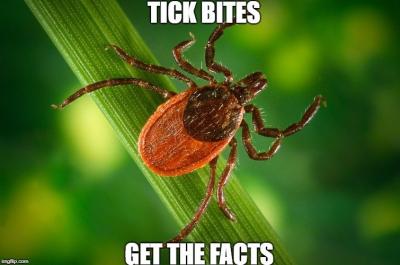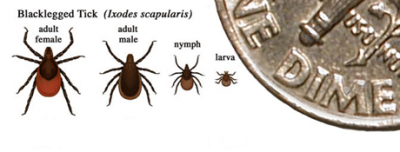Ticks and Lyme Disease

Facts:
Most tick bites are harmless and don’t need medical treatment. Some ticks (like the deer tick, wood tick, and others) can carry harmful germs that cause diseases like Rocky Mountain spotted fever and Lyme Disease. The deer tick is tiny, about the size of a poppy seed to a sesame seed. Other ticks are larger and easier to find on the skin.
- There are many different species of ticks. Check out this description of types of ticks.
- Maryland is one of 12 states where the majority of all Lyme disease cases occur.
- 20-30% of deer ticks in Maryland carry Lyme Disease.
- A tick must be attached to its host for 36 hours or longer to transmit disease.
- The rate of transmission of disease is only about 3% even if the deer tick is attached for 36 hours.
Sizes of deer ticks:

How Do I Remove a Tick?
It’s important to remove a tick as soon as possible. Follow these steps:
- Use tweezers to grasp the tick firmly at its head or mouth, next to the skin.
- Pull up slowly but firmly creating a “tent” with the skin. Don’t pull any more once the skin is tented up. Instead, hold steadily until the tick lets go of the skin. It may take as long as a minute or two for the tick to release, but it will let go on its own if you wait. Do not twist the tick or rock it from side to side. If part of the tick stays in the skin, don’t worry. It will eventually come out on its own.
- Release the tick into a jar or zip-locked bag.
- Wash your hands and the site of the bite with soap and water.
- Swab the bite site with alcohol.
Never use petroleum jelly, nail polish or a hot match to kill and remove a tick. These methods don’t get the tick off the skin, but may kill the tick which can cause it to release more saliva (which increases the chances of disease transmission).
Watch this video of Susan Emerson, CPNP showing you exactly how to remove a tick.
What Are the Signs of Tick-Related Diseases?
Watch out for:
- A red area ringed by an expanding red rash that looks like a bull’s-eye OR a large swollen joint, typically a knee (Lyme disease).
- Fever with red dots on the ankles and wrists (Rocky Mountain spotted fever).
When Should I Get Medical Care?
Call your health care provider if:
- The tick was attached to the skin for more than 36 hours.
- Part of the tick remains in the skin after attempted removal.
- A rash develops (especially a red-ringed bull’s-eye rash or red dots on wrists and ankles).
- The bite area looks infected (increasing warmth, swelling, pain, or oozing pus).
- Symptoms like fever, headache, tiredness, stiff neck or back, or muscle or joint aches develop. These symptoms do not at all necessarily mean the child has Lyme disease, but we should still talk about them.
How Can I Protect My Kids From Ticks?
- Make tick checks part of your routine, check kids every day for ticks especially after they have been playing outside. (all year long - especially in fall, spring & summer where grass and weeds may be higher) Check their skin and hair — especially the scalp, behind the ears, around the neck, and under the arms.
- Avoid tick-infested areas – wooded or brushy areas, tall grass during warm weather.
- Use an insect repellent with at least 10% to 30% DEET for protection against bites and stings in kids older than 2 months, always carefully following the directions for application.
- When playing in wooded areas, kids should wear long-sleeved shirts and pants and tuck pant legs into their socks.
- After play outside, high heat will kill ticks. Put clothing in the dryer right away on high heat to kill any ticks that may have attached to yours or your children’s clothing.
If you suspect a tick-related disease or are not sure if you should see a medical professional, call and talk to one of our triage nurses. Our nurses are available 24/7.
